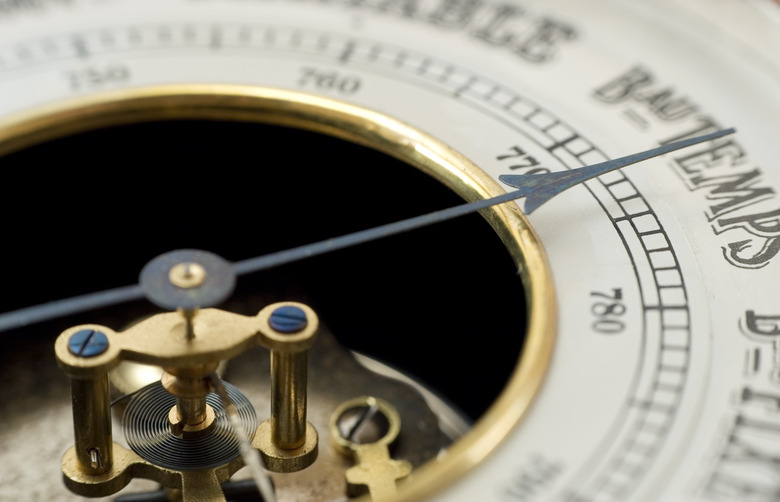How To Predict Weather By The Barometer
A well-adjusted barometer can help you predict changing weather day to day because it detects minute changes in the air pressure. A barometer with a dial typically has a series of numbers on the dial face of the barometer, which indicate changes in air pressure, with the words "Rain" at the 9:00 o'clock position, "Change" at the midnight position and "Fair" at the 3:00 o'clock position. Some barometers may also say "Stormy" right before "Rain" and "Very Dry" following "Fair." The dial moves as the air pressure changes to indicate the coming weather.
Predicting the Weather
Predicting the Weather
Changes in air pressure help meteorologists predict the weather, just like a barometer does for the amateur weatherperson. High-pressure systems in the atmosphere typically indicate clear and warm sunny days. Low-pressure changes on the other hand, signal an oncoming storm. Low-pressure systems go hand in hand with thunderstorms and clouds full of water ready to let the rain begin. In between those two conditions, the barometer dial would read "Change."
The First Barometer
The First Barometer
The first barometer, in 1648, consisted of a small pool of mercury in a bowl with a sealed-at-one-end glass tube sitting in the pool of mercury. Air pressure on the outside of the glass tube caused the mercury to climb up inside the column. When air pressure is high, signaling a clear and sunny day, the mercury from the pool rises inside the glass tube. When the air pressure drops, indicating an oncoming storm, the mercury inside the vacuum glass tube drops back into the pool at the bottom of the tube.
Types of Barometers
Types of Barometers
Barometers have changed significantly since the early days. Most people who have barometers inside their homes typically have an aneroid barometer. With a round body and dial face, this type of barometer contains an aneroid cell – a small cell or box without water – that changes its shape with increases in atmospheric pressure, which in turn changes the position of the dial. An altimeter is another type of barometer used in airplanes that measures altitude and air pressure. The other type of barometer – a "bar" meter – is the mercury barometer that measures the height of the mercury as a bar in a vacuum tube.
Make a Homemade Barometer
Make a Homemade Barometer
To make a barometer at home, the Kalamazoo Valley Museum says you need a small coffee can that's dry inside, a balloon and a wooden food or kebob skewer. Cut the neck from the balloon with scissors. Pull the balloon over the top of the can until the top of the balloon lays flat across the top of the can. You can use tape or glue to hold the balloon in place on the can. Add a dab of glue to the center of the balloon atop the can and attach one end of the wooden skewer to it.
Make certain you have something to hold the skewer in place as the glue dries. After the glue is dry, take a large colored index card and fold it in half lengthwise. Place the card behind the free end of the skewer. When the air pressure drops, the skewer lowers; as it rises, so does the skewer. You can mark the index card to signal the changes in weather with the words, "Rain," "Change" and "Fair," accordingly.
Cite This Article
MLA
Brenner, Laurie. "How To Predict Weather By The Barometer" sciencing.com, https://www.sciencing.com/predict-weather-barometer-5767204/. 7 May 2018.
APA
Brenner, Laurie. (2018, May 7). How To Predict Weather By The Barometer. sciencing.com. Retrieved from https://www.sciencing.com/predict-weather-barometer-5767204/
Chicago
Brenner, Laurie. How To Predict Weather By The Barometer last modified March 24, 2022. https://www.sciencing.com/predict-weather-barometer-5767204/
